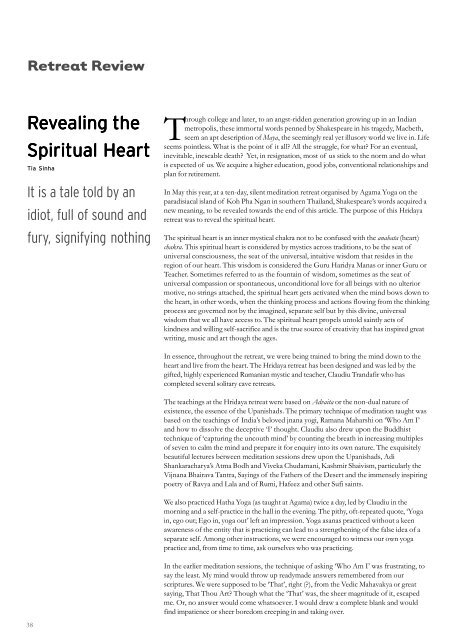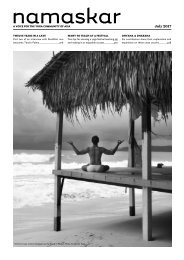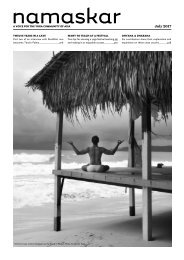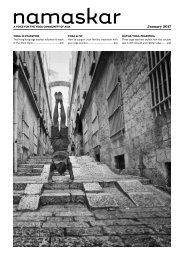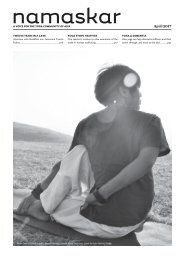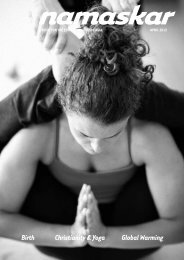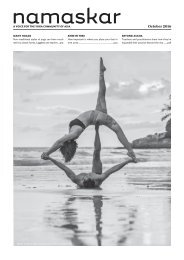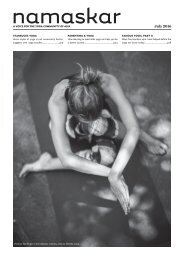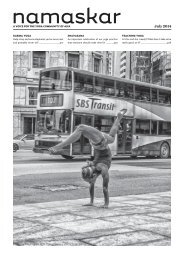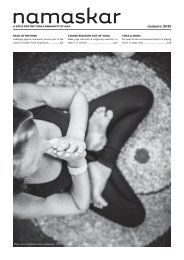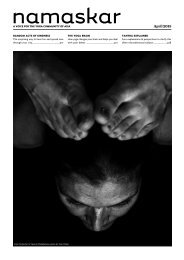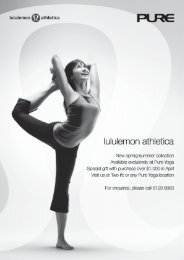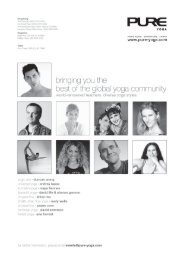Namaskar - Oct 09
You also want an ePaper? Increase the reach of your titles
YUMPU automatically turns print PDFs into web optimized ePapers that Google loves.
Retreat Review<br />
Revealing the<br />
Spiritual Heart<br />
Tia Sinha<br />
It is a tale told by an<br />
idiot, full of sound and<br />
fury, signifying nothing<br />
Through college and later, to an angst-ridden generation growing up in an Indian<br />
metropolis, these immortal words penned by Shakespeare in his tragedy, Macbeth,<br />
seem an apt description of Maya, the seemingly real yet illusory world we live in. Life<br />
seems pointless. What is the point of it all? All the struggle, for what? For an eventual,<br />
inevitable, inescable death? Yet, in resignation, most of us stick to the norm and do what<br />
is expected of us. We acquire a higher education, good jobs, conventional relationships and<br />
plan for retirement.<br />
In May this year, at a ten-day, silent meditation retreat organised by Agama Yoga on the<br />
paradisiacal island of Koh Pha Ngan in southern Thailand, Shakespeare’s words acquired a<br />
new meaning, to be revealed towards the end of this article. The purpose of this Hridaya<br />
retreat was to reveal the spiritual heart.<br />
The spiritual heart is an inner mystical chakra not to be confused with the anahata (heart)<br />
chakra. This spiritual heart is considered by mystics across traditions, to be the seat of<br />
universal consciousness, the seat of the universal, intuitive wisdom that resides in the<br />
region of our heart. This wisdom is considered the Guru Haridya Manas or inner Guru or<br />
Teacher. Sometimes referred to as the fountain of wisdom, sometimes as the seat of<br />
universal compassion or spontaneous, unconditional love for all beings with no ulterior<br />
motive, no strings attached, the spiritual heart gets activated when the mind bows down to<br />
the heart, in other words, when the thinking process and actions flowing from the thinking<br />
process are governed not by the imagined, separate self but by this divine, universal<br />
wisdom that we all have access to. The spiritual heart propels untold saintly acts of<br />
kindness and willing self-sacrifice and is the true source of creativity that has inspired great<br />
writing, music and art though the ages.<br />
In essence, throughout the retreat, we were being trained to bring the mind down to the<br />
heart and live from the heart. The Hridaya retreat has been designed and was led by the<br />
gifted, highly experienced Rumanian mystic and teacher, Claudiu Trandafir who has<br />
completed several solitary cave retreats.<br />
The teachings at the Hridaya retreat were based on Advaita or the non-dual nature of<br />
existence, the essence of the Upanishads. The primary technique of meditation taught was<br />
based on the teachings of India’s beloved jnana yogi, Ramana Maharshi on ‘Who Am I’<br />
and how to dissolve the deceptive ‘I’ thought. Claudiu also drew upon the Buddhist<br />
technique of ‘capturing the uncouth mind’ by counting the breath in increasing multiples<br />
of seven to calm the mind and prepare it for enquiry into its own nature. The exquisitely<br />
beautiful lectures between meditation sessions drew upon the Upanishads, Adi<br />
Shankaracharya’s Atma Bodh and Viveka Chudamani, Kashmir Shaivism, particularly the<br />
Vijnana Bhairava Tantra, Sayings of the Fathers of the Desert and the immensely inspiring<br />
poetry of Ravya and Lala and of Rumi, Hafeez and other Sufi saints.<br />
We also practiced Hatha Yoga (as taught at Agama) twice a day, led by Claudiu in the<br />
morning and a self-practice in the hall in the evening. The pithy, oft-repeated quote, ‘Yoga<br />
in, ego out; Ego in, yoga out’ left an impression. Yoga asanas practiced without a keen<br />
awareness of the entity that is practicing can lead to a strengthening of the false idea of a<br />
separate self. Among other instructions, we were encouraged to witness our own yoga<br />
practice and, from time to time, ask ourselves who was practicing.<br />
In the earlier meditation sessions, the technique of asking ‘Who Am I’ was frustrating, to<br />
say the least. My mind would throw up readymade answers remembered from our<br />
scriptures. We were supposed to be ‘That’, right (?), from the Vedic Mahavakya or great<br />
saying, That Thou Art? Though what the ‘That’ was, the sheer magnitude of it, escaped<br />
me. Or, no answer would come whatsoever. I would draw a complete blank and would<br />
find impatience or sheer boredom creeping in and taking over.<br />
38


